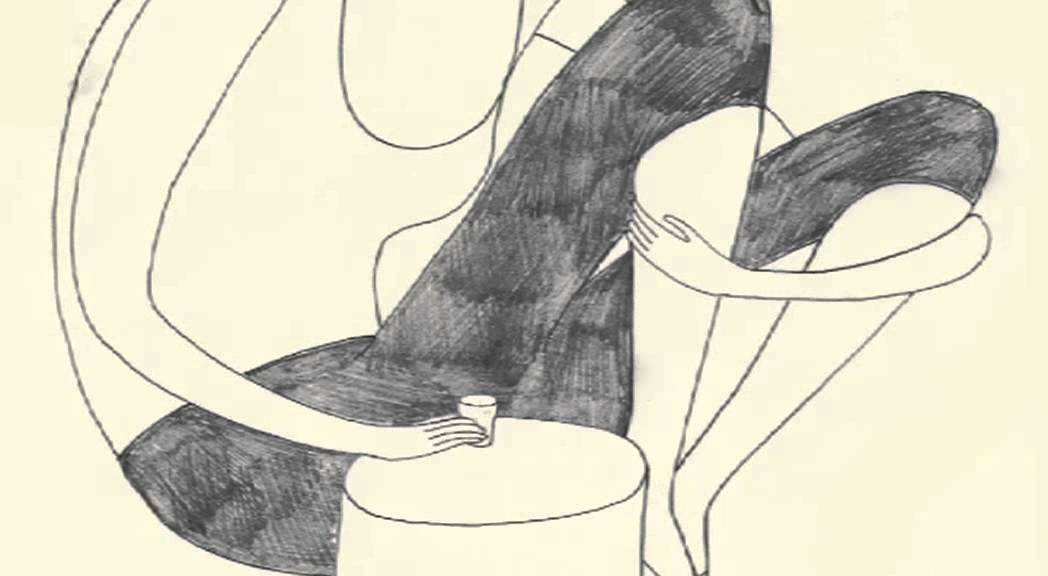Who found who first or were you always friends with Tom Rosenthal? How did your collaboration begin – you both seemed to have evolved over the last three videos and this latest one, Little Big Mistakes is a cracker.
Thank you! I met Tom on a pavement. I’d just finished my Masters at Central St Martins and a friend of mine from the course was given a small show in the window of an East London ad agency.
Milling around on the street I bumped into a very gregarious young man whose manners seemed to conflict with the stuffy British reserve I’d brought along for the evening. In amongst the uninvited backslaps and hugs he told me he was a musician and very keen to work with animators and filmmakers. He gave me his details and the next day I discovered the most incredible collection of songs, simultaneously funny, tender and delicate.
It’s much easier to make videos for songs you love and every one was brilliant. Working with Tom has really lifted my work to unexpected territories. I think I grew up with quite the arrogant myth that an artist is some enigmatic loner. I’ve since learned that with collaboration you can produce things that are far, far more than the sum of its parts.
Did you collaborate together on the narrative or did you have complete creative freedom to develop the lyrics into any which way you wanted to?
For ‘Little Big Mistakes’ Tom came to me with the complete song and just let me at it. It starts very wordy with lots of imagery so the fun for me was making witty visual connections to each line. I do enjoy being given something to take the mickey out of. As a cartoonist so everything for me starts with a written joke.
‘Puzzler Girl’ was one such animation which started as a one-line gag which I then developed into a pun-laden narrative. Tom then put the words to music and once again the collaboration produced something far better than either of us expected.
What were the major challenges of the animation? And the best bits?
The most ambitious section was the 3D fly through at the end. Tom presented me with this minute-long instrumental and said words like “dreamy” and “trippy” at me. Having been used to compiling my animations in short clips this was a great opportunity to try something different.
I went to work building a simple 3D landscape in After Effects, which was new territory for me. Nothing too complicated – I was quite keen on it looking a bit like a vintage computer game. Unfortunately it was all proving too much for my little laptop.
Eventually everything ground to a halt and I had no way to preview my animation as I was making it. I was having a beer with some expat friends in Lima moaning about how on earth I’m going to process this massive animation. Then a huge, tattooed Yorkshireman, who looked every bit the pirate minus the parrot, piped up from across the bar. He was a 3D designer at an architects firm in Lima and kindly enlisted all the machines at his office to chew though my work. “Big Chris” really did save it and for something that was built on guesswork it slotted into the music beautifully.
We see you’re an experienced storyboard artist too. Is this a completely different process from your animation work?
With the storyboard work I’m usually handed a script in advance then it’s a conversation with the director and together we work through the key images. I have an editor friend who told me what’s good about his job is making the director think he’s making the movie whilst in fact you’re directing it yourself. It’s not quite that extreme, but the people I love working for are very much open to conversation.
The Harry Hill Movie out this week is one such project where the director asked, “what do you think?”. I am producing the first visual representation of the script but it’s often the constraints or possibilities of producing a simple and communicative drawing that will often dictate what the crew will later do with a camera.
It’s great sometimes to see small details on screen and think “that was my idea”. The connection to the animation work I suppose is once again is trying to make as much visual fun as possible out of the words you’ve been given, which are mostly set in stone.
To what extent do you hand draw and digitally draw?
Everything starts with pens and paper. Even if it might not actually be used as the final thing, every scene begins as a pencil drawing. Once it’s scanned in I’ll try other Photoshop or After Effects flourishes but I’m getting to the point now though where, after working in the same way for a while it’s high time I changed things a bit and try new methods.
It’s important to always remain a student (without getting up at two in the afternoon). Seeing what a 3D animator can do recently for example has shown me new avenues I never thought I wouldn’t be interested in.
LINKS:














